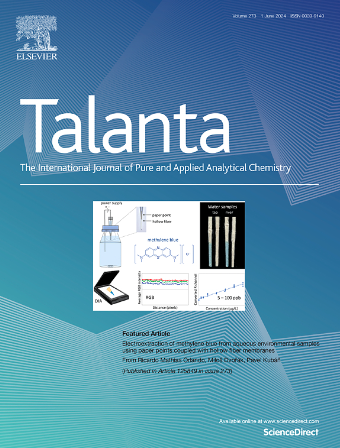Constructing amino and hydroxyl group co-modified porous organic polymers for the efficient enrichment of phenoxyacetic acid herbicides and their determination by HPLC-UV
IF 5.6
1区 化学
Q1 CHEMISTRY, ANALYTICAL
引用次数: 0
Abstract
As hormone-type herbicides, phenoxyacetic acid herbicides (PAAs) residues in environment and food pose severe risks to human health. In this study, a hydroxyl and amino modified azo-linked porous polymer (NH-OH-POP) was synthesized for the first time. As a solid-phase extraction (SPE) adsorbent, NH-OH-POP achieved efficient enrichment of PAAs across a broad pH range (pH 1–9), far surpassing the pH range of all previously reported adsorbents. With NH-OH-POP as SPE adsorbent, a highly efficient high-performance liquid chromatography method for the analysis of trace PAAs in real water and vegetable samples has been established. The method demonstrated good linearity (determination coefficient >0.998), high sensitivity (detection limits of 0.08–0.30 ng mL−1 for water, 6.00–18.0 ng g−1 for wax gourd, and 6.50–20.0 ng g−1 for cucumber), and high recovery rates (87.4–107 %), with relative standard deviations below 7.2 %. This work can shed light on constructing multifunctional POPs for the robust enrichment and detection of acidic organic pollutants.

求助全文
约1分钟内获得全文
求助全文
来源期刊

Talanta
化学-分析化学
CiteScore
12.30
自引率
4.90%
发文量
861
审稿时长
29 days
期刊介绍:
Talanta provides a forum for the publication of original research papers, short communications, and critical reviews in all branches of pure and applied analytical chemistry. Papers are evaluated based on established guidelines, including the fundamental nature of the study, scientific novelty, substantial improvement or advantage over existing technology or methods, and demonstrated analytical applicability. Original research papers on fundamental studies, and on novel sensor and instrumentation developments, are encouraged. Novel or improved applications in areas such as clinical and biological chemistry, environmental analysis, geochemistry, materials science and engineering, and analytical platforms for omics development are welcome.
Analytical performance of methods should be determined, including interference and matrix effects, and methods should be validated by comparison with a standard method, or analysis of a certified reference material. Simple spiking recoveries may not be sufficient. The developed method should especially comprise information on selectivity, sensitivity, detection limits, accuracy, and reliability. However, applying official validation or robustness studies to a routine method or technique does not necessarily constitute novelty. Proper statistical treatment of the data should be provided. Relevant literature should be cited, including related publications by the authors, and authors should discuss how their proposed methodology compares with previously reported methods.
 求助内容:
求助内容: 应助结果提醒方式:
应助结果提醒方式:


